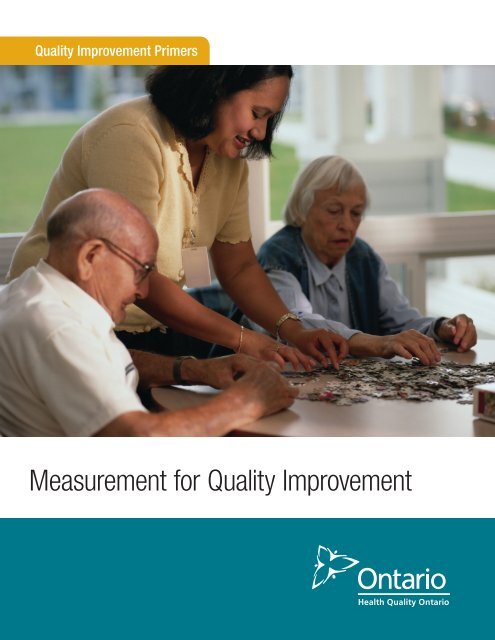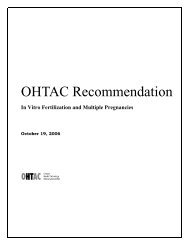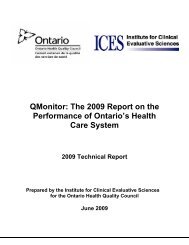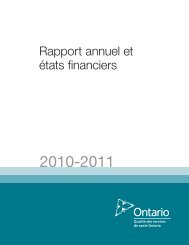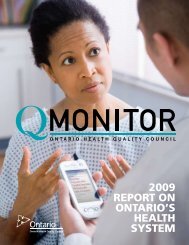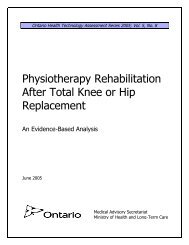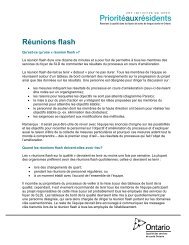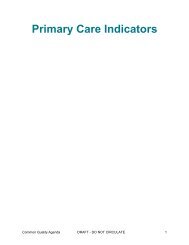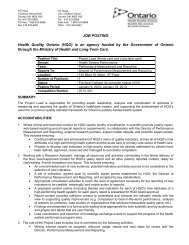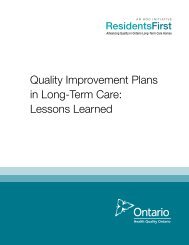Measurement for Quality Improvement - Health Quality Ontario
Measurement for Quality Improvement - Health Quality Ontario
Measurement for Quality Improvement - Health Quality Ontario
You also want an ePaper? Increase the reach of your titles
YUMPU automatically turns print PDFs into web optimized ePapers that Google loves.
<strong>Quality</strong> <strong>Improvement</strong> Primers<br />
<strong>Measurement</strong> <strong>for</strong> <strong>Quality</strong> <strong>Improvement</strong>
ACKNOWLEDGEMENTS<br />
This workbook is the result of the ef<strong>for</strong>ts of the <strong>Health</strong> <strong>Quality</strong> <strong>Ontario</strong> (HQO) For additional in<strong>for</strong>mation about other<br />
resources, contact: <strong>Health</strong> <strong>Quality</strong> <strong>Ontario</strong> www.hqontario.ca<br />
Individuals may reproduce these materials <strong>for</strong> their use provided that proper attribution is given to the appropriate<br />
source. The recommended citation <strong>for</strong> this resource guide is: <strong>Health</strong> <strong>Quality</strong> <strong>Ontario</strong> (April 2013).<br />
HQO is funded by the <strong>Ontario</strong> Ministry of <strong>Health</strong> and Long-Term Care (MOHLTC).<br />
© Queen’s Printer <strong>for</strong> <strong>Ontario</strong>, 2013
Table of Contents<br />
Overview of <strong>Measurement</strong>. ...................................................................4<br />
Effective <strong>Measurement</strong> in <strong>Quality</strong> <strong>Improvement</strong> ...............................................4<br />
Strategies <strong>for</strong> Successful <strong>Measurement</strong>. .......................................................5<br />
Develop a measurement plan .............................................................5<br />
Use multiple measures. ..................................................................6<br />
Plan-Do-Study-Act (PDSA) . ..................................................................7<br />
Leading and Lagging indicators: ..............................................................7<br />
Choose appropriate measures to understand your system. ......................................8<br />
Integrate measures into your daily routine. ...................................................9<br />
Plot data over time. ......................................................................9<br />
Develop visual displays of measures. ......................................................10<br />
Build in ongoing measurement and communication ...........................................10<br />
Sample Measures .........................................................................10<br />
Using Sampling: An Example ............................................................10<br />
<strong>Measurement</strong>: Run Charts ..................................................................11<br />
Why Use Run Charts? ..................................................................11<br />
Run Charts to Engage Leadership and Staff ................................................13<br />
Analyzing and Understanding Run Charts . ....................................................14<br />
<strong>Measurement</strong> <strong>for</strong> <strong>Quality</strong> <strong>Improvement</strong> | <strong>Health</strong> <strong>Quality</strong> <strong>Ontario</strong> 3
OVERVIEW OF MEASUREMENT<br />
<strong>Measurement</strong> in quality improvement allows a <strong>Quality</strong> <strong>Improvement</strong> (QI)<br />
team to demonstrate current per<strong>for</strong>mance (or baseline), set goals <strong>for</strong><br />
future per<strong>for</strong>mance, and monitor the effects of changes as they are made.<br />
Successful measurement is a cornerstone of successful improvement. How<br />
do you know if the changes you are making are leading to improvement?<br />
Simple – you measure. <strong>Measurement</strong> does not have to be difficult or<br />
time-consuming. The key is to pick the right measures so that the quality<br />
improvement team can see results quickly and are able to adapt their<br />
interventions accordingly, putting less strain on resources and more focus on<br />
outcomes.<br />
Of the many types of measurement, two are typically utilized in health care:<br />
measurement <strong>for</strong> research and measurement <strong>for</strong> improvement. Traditionally,<br />
health care providers are trained to look at research; however, measurement<br />
<strong>for</strong> research is very different from measurement <strong>for</strong> improvement. The<br />
differences are outlined in the table below.<br />
<strong>Measurement</strong> <strong>for</strong><br />
Research<br />
<strong>Measurement</strong> <strong>for</strong> Learning<br />
and Process <strong>Improvement</strong><br />
Purpose<br />
Tests<br />
Biases<br />
Data<br />
Duration<br />
To discover new knowledge<br />
One large “blind” test<br />
Control <strong>for</strong> as many biases<br />
as possible<br />
Gather as much data as<br />
possible, “just in case”<br />
Can take long periods of time<br />
to obtain results<br />
To bring new knowledge into<br />
daily practice<br />
Many sequential, observable<br />
tests<br />
Stabilize the biases from test<br />
to test<br />
Gather “just enough” data to<br />
learn and complete another<br />
cycle<br />
“Small tests of significant<br />
changes” approach<br />
accelerates the rate of<br />
improvement<br />
EFFECTIVE MEASUREMENT IN QUALITY IMPROVEMENT<br />
In order to recognize when we have achieved our goals, it is important<br />
to define what our ‘better’ state looks like, and measure to know if the<br />
changes we make result in the improvements we seek. The best approach is<br />
through the measurement of items called indicators, per<strong>for</strong>mance measures<br />
or measures.<br />
4 <strong>Measurement</strong> <strong>for</strong> <strong>Quality</strong> <strong>Improvement</strong> | <strong>Health</strong> <strong>Quality</strong> <strong>Ontario</strong>
Begin brainstorming change ideas and associated measurements by asking<br />
the following questions:<br />
• What are the current outcomes?<br />
• What outcomes are desired?<br />
• What are the processes and activities that have an impact on the<br />
outcomes?<br />
• How are these processes per<strong>for</strong>ming?<br />
• Are the processes stable and reliable?<br />
• What will the impact of one process change be on the outcomes?<br />
• What will the impact be on other parts of the system if one process is<br />
changed?<br />
All of these questions require a comprehensive understanding of the system<br />
or how the various processes work together to achieve outcomes. In quality<br />
improvement, this is called a “family of measures,” which provide a view of<br />
the system from the outcomes, to the processes, to the unintended impacts.<br />
STRATEGIES FOR SUCCESSFUL MEASUREMENT<br />
The strategies below will help the improvement team bring these<br />
measurement guidelines to the improvement projects underway in your<br />
organization.<br />
Develop a measurement plan<br />
Convene the improvement team and agree on the following:<br />
1. Name of measure<br />
2. Type of measure (outcome, process or balancing, see below)<br />
3. Why the measure is needed <strong>for</strong> the project<br />
4. Operational definition<br />
5. Data collection and sampling method<br />
6. How will data be displayed?<br />
7. Is baseline data available?<br />
8. Is there a goal or target?<br />
9. Source<br />
What will be measured, how often will it be measured, who will be<br />
responsible <strong>for</strong> measurement, and how will the measurements be shared with<br />
the team, leadership and the organization are important questions to answer.<br />
Review this plan with the team regularly to ensure that it is working and that<br />
there is clarity about what the team is trying to achieve by measuring their<br />
progress. Also, make sure that the data collected and analyzed is shared<br />
with all stakeholders. It is difficult to create momentum among staff without<br />
providing them with relevant and timely in<strong>for</strong>mation.<br />
><br />
Examples of outcome measures:<br />
• For diabetes: Average<br />
hemoglobin A1c level <strong>for</strong><br />
population of patients with<br />
diabetes.<br />
• For access: Number of<br />
days to third next available<br />
appointment.<br />
• For critical care: Intensive Care<br />
Unit (ICU) percent unadjusted<br />
mortality.<br />
• For medication systems:<br />
Adverse drug events per 1,000<br />
doses.<br />
<strong>Measurement</strong> <strong>for</strong> <strong>Quality</strong> Improvment| <strong>Health</strong> <strong>Quality</strong> <strong>Ontario</strong> 5
Examples of process measures:<br />
• For diabetes: Percentage of<br />
patients whose hemoglobin<br />
A1c level was measured each<br />
quarter in the past year<br />
• For access: Average daily<br />
clinician hours available <strong>for</strong><br />
appointments.<br />
• For acute care: Percentage<br />
of patients <strong>for</strong> whom a<br />
LACE score was calculated.<br />
(LACE stands <strong>for</strong>: Length of<br />
Stay, Acuity of admission,<br />
Comorbidities [as measured by<br />
a Charlson Score] and number<br />
of previous ED visits)<br />
<<br />
Use multiple measures.<br />
Consider each category of measures listed below. Collect and plot the<br />
data on these measures to create a “family of measures.” This will ensure<br />
that you have an accurate picture of the effects of the changes your quality<br />
improvement team has tested.<br />
Outcome measures are the “voice of the patient or customer” and capture<br />
system per<strong>for</strong>mance. They answer the question: “What are the end results of<br />
our QI work.” 1<br />
Process measures are the “voice of the workings of the system.” In other<br />
words, process measurements are those that capture the changes your<br />
quality improvement ef<strong>for</strong>ts make to the inputs or steps that contribute to<br />
system outcomes. When working with process measures, it is important<br />
to focus on the processes that directly contribute to the outcome that is<br />
desired. 2<br />
A good example of linking the process measure to the outcome is measuring<br />
the percentage of time staff comply with a best practice recommendation<br />
that will prevent a negative patient outcome (<strong>for</strong> example, bundle compliance<br />
with the ‘bundle’ of best practices to prevent ventilator associated<br />
pneumonia).<br />
Balancing measures determine whether changes designed to improve<br />
one part of the system are causing new problems in other parts of the<br />
system. For example, does this new QI change improve staff satisfaction but<br />
decrease client satisfaction?<br />
PDSA Measures are those that are collected with each test of change<br />
(PDSA) that is carried out. These measures provide in<strong>for</strong>mation about the<br />
effect of each change attempt.<br />
6 <strong>Measurement</strong> <strong>for</strong> <strong>Quality</strong> <strong>Improvement</strong> | <strong>Health</strong> <strong>Quality</strong> <strong>Ontario</strong>
PLAN-DO-STUDY-ACT (PDSA)<br />
Step 1<br />
Step 2<br />
Step 3<br />
Step 4<br />
PLAN (who, what, where, when, and why)<br />
• State the purpose of the PDSA—are you developing a<br />
change idea, testing a change, or implementing a change?<br />
• What is your change idea?<br />
• What indicator(s) of success will you measure?<br />
• How will data on these indicators be collected?<br />
• Who or what are the subjects of the test?<br />
• How many subjects will be included in the test and over<br />
what time period?<br />
• What are your predictions as to what will happen?<br />
DO<br />
• Conduct the test.<br />
• Document the results, measurements, challenges and<br />
unintended consequences.<br />
STUDY<br />
• Analyze the data and study the results.<br />
• Compare the data to your predictions.<br />
• Summarize and reflect on what was learned.<br />
ACT<br />
• Refine the change idea based on lessons learned from the<br />
test.<br />
• Prepare a plan <strong>for</strong> the next test. Dependent on results the<br />
idea should be adopted, adapted or abandoned.<br />
LEADING AND LAGGING INDICATORS:<br />
“Leading” and lagging” indicators offer more ways of gaining knowledge<br />
about how a system is per<strong>for</strong>ming and where to focus your quality<br />
improvement ef<strong>for</strong>ts.<br />
A leading indicator provides in<strong>for</strong>mation about how a process is per<strong>for</strong>ming<br />
after changes have been implemented. A lagging indicator is one that<br />
provides in<strong>for</strong>mation about how the system is per<strong>for</strong>ming after changes have<br />
been made. In quality improvement, process measures are usually referred<br />
to as “leading,” while outcome measures are referred to as “lagging”. If<br />
the per<strong>for</strong>mance of a process measure begins to drop, it is likely that the<br />
per<strong>for</strong>mance of an outcome measure will also decline. 3<br />
For example, assessment of residents in long-term care <strong>for</strong> falls (process) will<br />
typically serve to prevent falls (outcome), as actions are taken in response to<br />
what is learned in the assessment. If the quality improvement team focused<br />
on the level of completion of these assessments over time and discovered<br />
that the rate of completion declined, it would be a fairly good predictor<br />
<strong>Measurement</strong> <strong>for</strong> <strong>Quality</strong> Improvment| <strong>Health</strong> <strong>Quality</strong> <strong>Ontario</strong> 7
that the level of falls would increase. Constantly measuring and monitoring<br />
process measures can help the team to understand what may be causing a<br />
decline in outcomes, and can also help the team avoid negative outcomes<br />
be<strong>for</strong>e they happen.<br />
Choose appropriate measures to understand your system.<br />
Raw data is hard to compare. Statistics are used to organize and summarize<br />
the in<strong>for</strong>mation that is collected. The basic summarizing statistics that are<br />
likely used in your quality improvement ef<strong>for</strong>ts are:<br />
Counts: A count of how many items or observations<br />
Example: the number of people responding to a survey<br />
Sums:<br />
Adding up the number of items or observations<br />
Example: 20 out of 100 people surveyed feel that communication<br />
with their healthcare provider is inadequate<br />
Ratio:<br />
A fraction that describes two groups relative to one another.<br />
Example: the ratio of females to males in the study<br />
Rate:<br />
A ratio that describes one quantity in relation to a certain unit.<br />
Example: the rate of infection expressed per 1000 patients<br />
Rates, ratios and percentages help you standardize your data so that it is<br />
expressed in a meaningful way that can be readily compared with other<br />
data. Ratios and rates may be expressed as percentages. How you choose<br />
to present your data will depend on the nature of your data and how you<br />
plan to use it.<br />
Ratios (percentages) may be used to adjust <strong>for</strong> the impact of natural changes<br />
in your system, such as volume. The numerator is the key measure (e.g.,<br />
costs, patients waiting) and the denominator is the unit of production or<br />
volume (e.g., total costs, total patients waiting). For example, if the number<br />
of patients waiting <strong>for</strong> more than one hour increased dramatically, you might<br />
draw one conclusion. If you knew that overall volume had also increased<br />
(which would show up in the ratio), you would mostly likely draw another,<br />
more accurate, conclusion.<br />
Sometimes the denominator may be so large that the change looks<br />
imperceptible. For example, one year the rate of Ventilator Acquired<br />
Pneumonia (VAP) in a hospital was 0.13% and the following year it was<br />
0.26%. That rate is less than one percent of the patients treated. There<strong>for</strong>e,<br />
it rose slightly, but not by much. To look at your system from a more<br />
detailed perspective, use whole numbers, which provide more in<strong>for</strong>mation<br />
about what is happening on a daily basis, without the “watering-down”<br />
8 <strong>Measurement</strong> <strong>for</strong> <strong>Quality</strong> <strong>Improvement</strong> | <strong>Health</strong> <strong>Quality</strong> <strong>Ontario</strong>
effect of a ratio. Real numbers speak more directly to the experience of<br />
your customers. How many customers are experiencing “x”? In the case<br />
of the VAP example - in the first year, two people acquired VAP and the<br />
following year four people did. Since VAPis almost always preventable, an<br />
additional two people experiencing a secondary, needless hospital induced<br />
illness, while suffering from a critical illness, is serious. Although it is useful<br />
to understand an increase in volume (as in the above example of patients<br />
waiting), it is crucial to understand the experience of each patient when<br />
conducting improvement work.<br />
Integrate measures into your daily routine.<br />
To see if changes are leading to improvement, use the “get just enough<br />
data” approach. Where measurements are gathered by auditing patient/<br />
client/resident charts, <strong>for</strong> example, decide how many charts will provide<br />
enough data <strong>for</strong> a fairly accurate depiction of your system and consistently<br />
use that number to measure over time. Graph and display your measures<br />
often enough to give your team feedback in a timely manner, both to keep up<br />
momentum and to learn of changes that are having adverse effects. Monthly<br />
graphs are often best suited <strong>for</strong> larger outcome measures whereas weekly<br />
graphs may be preferable <strong>for</strong> smaller, more variable process measures. In<br />
your quality improvement team, ensure that there is enough time allotted <strong>for</strong><br />
staff to review the results and plan the next steps.<br />
Try to build data collection into the daily routine instead of making it a<br />
separate project. This not only ensures that data is timely but also reduces<br />
stress by making measurement something that is simple to do. Create data<br />
collection <strong>for</strong>ms that include only the in<strong>for</strong>mation you need and that are<br />
easy to fill out. When integrating measurement into a staff member’s role,<br />
be sure to build in a contingency plan <strong>for</strong> ongoing collection should that<br />
person be unavailable.<br />
Plot data over time.<br />
Although one of the more common ways to collect and display data is the<br />
pre/post method (i.e., collect data be<strong>for</strong>e and after a change to the system<br />
or process), displaying data in bar charts is of limited value to improvement<br />
ef<strong>for</strong>ts because it does not answer the question “What are the effects of<br />
making this change?” Summary statistics can hide in<strong>for</strong>mation about outliers<br />
and patterns. In improvement ef<strong>for</strong>ts, changes are not fixed but continuously<br />
adapted over time.<br />
The best way to collect and display data is to use run charts and statistical<br />
control charts –graphical records of a measure plotted over time (often<br />
months). Charts annotated with changes and events provide even more<br />
in<strong>for</strong>mation and can help you more accurately make connections between<br />
interventions/events and outcomes.<br />
<strong>Measurement</strong> <strong>for</strong> <strong>Quality</strong> Improvment| <strong>Health</strong> <strong>Quality</strong> <strong>Ontario</strong> 9
When measuring effects or incidents that are extreme but episodic (<strong>for</strong><br />
example, the outbreak of an illness), tracking the time between episodes will<br />
give you more useful in<strong>for</strong>mation.<br />
Develop visual displays of measures.<br />
Visual displays are communication tools, motivators, reality checks, and<br />
validations of work already done. They don’t need to be perfect, just useful.<br />
And don’t wait until in<strong>for</strong>mation systems are ready - start with simple data<br />
collection methods such as paper and a pencil. Having clearly visible data<br />
will point the improvement team in the right direction.<br />
Build in ongoing measurement and communication<br />
Establishing an ongoing measurement system and a standardized way<br />
of communicating results rein<strong>for</strong>ces the idea that change is important to<br />
the organization. By creating and sharing the collected data, the quality<br />
improvement team is likely to gain the support of the organization as a whole.<br />
SAMPLE MEASURES<br />
When collecting measures <strong>for</strong> a quality improvement project, teams often ask<br />
how much they should collect. Should every patient chart be examined and<br />
recorded? Should every element that touches the outcome be measured?<br />
The very simple answer is to measure enough to create knowledge and<br />
understanding about the system. Each system is different, so whether<br />
examining five charts is enough or it takes ten, it is important not to overwhelm<br />
the improvement team by creating so much work that it cannot get the<br />
measurements done. It is, however, crucial to ask whether what is being<br />
measured gives enough in<strong>for</strong>mation to understand how the system is per<strong>for</strong>ming<br />
and how it will react to planned changes. Once “how much” has been<br />
determined, it is necessary to determine “how often,” still keeping in mind the<br />
availability of the in<strong>for</strong>mation and of the team to carry out the measurement.<br />
Using Sampling: An Example<br />
Here is how one team used sampling to measure the time <strong>for</strong> transfer from<br />
Emergency Department (ED) to inpatient bed. Rapid movement from the<br />
ED after the decision to admit a patient is critical to the entire system <strong>for</strong><br />
emergent patient care.<br />
10 <strong>Measurement</strong> <strong>for</strong> <strong>Quality</strong> <strong>Improvement</strong> | <strong>Health</strong> <strong>Quality</strong> <strong>Ontario</strong>
Sampling Approach<br />
The measurement consisted of six weekly data collections of 25 patients<br />
each. The patients were sampled in several ways:<br />
5 patients per day <strong>for</strong><br />
5 days of the week.<br />
The patients must be<br />
consecutive and at<br />
least one day must<br />
be a weekend day;<br />
25 consecutive<br />
patients regardless<br />
of any specific day;<br />
excpet that it must<br />
include some<br />
weekend admissions;<br />
If there are fewer<br />
than 25 admissions<br />
<strong>for</strong> a week, the total<br />
admissions <strong>for</strong> the<br />
week should be<br />
included in the sample.<br />
OR<br />
OR<br />
Time was measured from the “decision to admit” to the arrival of the patient<br />
in the inpatient room. The destination could not be a “holding area” but had<br />
to be a real inpatient bed. The sample collection was done in real time. So, a<br />
data collection process had to be created by members of the team that were<br />
collecting the data. In this example, the collections had to be done weekly<br />
and summarized as the percentage of patients in the sample that achieved<br />
the goal <strong>for</strong> that week. Six weeks of data had to be collected and six data<br />
points placed on a run chart.<br />
MEASUREMENT: RUN CHARTS<br />
Why Use Run Charts?<br />
There are many ways that data can be presented to tell the story of a project<br />
or improvement. Whether you use histograms, pie charts or run charts, the<br />
intention is the same: to gain new knowledge and to engage the audience,<br />
whether they are leaders, staff or customers. However, some graphical<br />
representations can be misleading.<br />
Figure 1<br />
><br />
Figure 1 is an example of work<br />
by an improvement team <strong>for</strong>med in<br />
response to complaints from staff<br />
about delays in processing test<br />
results. This chart demonstrates the<br />
length of time (in hours) that it took<br />
<strong>for</strong> test results to be completed<br />
and received by staff. The graph<br />
demonstrates the changes<br />
measured at Week 4 and Week 11.<br />
During Week 4 (that is, four weeks<br />
after the team was <strong>for</strong>med), the<br />
team collected data to confirm<br />
or deny the complaints they were<br />
hearing. The data show that the<br />
turnaround time was eight hours,<br />
unacceptable by any standard. At<br />
Week 7, after the solution design<br />
process, the team tested a change.<br />
Measuring again during Week 11,<br />
they found that the turnaround time<br />
was now three hours. The reduction<br />
in cycle time from eight hours<br />
to three hours is significant and<br />
represents a 62.5% improvement.<br />
<strong>Measurement</strong> <strong>for</strong> <strong>Quality</strong> Improvment| <strong>Health</strong> <strong>Quality</strong> <strong>Ontario</strong> 11
Scenario One – this graph depicts<br />
14 weeks of data, seven weeks<br />
prior to change and seven weeks<br />
post- change. This run chart would<br />
support the conclusion that the<br />
change resulted in meaningful<br />
improvement and that the process<br />
should become the new standard.<br />
Scenario Two – there is no obvious<br />
improvement after the change was<br />
made. The measures made during<br />
the test are typical results from a<br />
process that has a lot of week-toweek<br />
variation. The conclusion that<br />
can be drawn from a study of the run<br />
chart is that the change did not have<br />
any obvious impact on cycle time.<br />
Scenario Three – It appears that<br />
the process steadily improved over<br />
the 14-week period. However, the<br />
rate of improvement did not change<br />
when the change was introduced<br />
in Week 7. Although the cycle time<br />
<strong>for</strong> the process certainly improved,<br />
there is no evidence that the change<br />
made any contribution to the steady<br />
improvement in the process.<br />
<<br />
Below are a number of scenarios that could have resulted in the above be<strong>for</strong>eand-after<br />
bar graph. In each case, a run chart of the cycle-time <strong>for</strong> Weeks 1 to<br />
14 is shown. The test results <strong>for</strong> Week 4 (cycle time of eight hours) and Week<br />
11 (cycle time of three hours) are the same <strong>for</strong> all cases/scenarios. 4<br />
Daily Time (Hours)<br />
Daily Time (Hours)<br />
Daily Time (Hours)<br />
10<br />
9<br />
8<br />
7<br />
6<br />
5<br />
4<br />
3<br />
2<br />
1<br />
0<br />
10<br />
8<br />
6<br />
4<br />
2<br />
0<br />
10<br />
8<br />
6<br />
4<br />
2<br />
0<br />
1 2 3 4 5 6 7 8 9 10 11 12 13 14<br />
Week<br />
1 2 3 4 5 6 7 8 9 10 11 12 13 14<br />
Week<br />
Week<br />
1 2 3 4 5 6 7 8 9 10 11 12 13 14<br />
Week<br />
Daily Time (Hours)<br />
10<br />
8<br />
6<br />
4<br />
12 2 <strong>Measurement</strong> <strong>for</strong> <strong>Quality</strong> <strong>Improvement</strong> | <strong>Health</strong> <strong>Quality</strong> <strong>Ontario</strong><br />
0
0<br />
1 2 3 4 5 6 7 8 9 10 11 12 13 14<br />
Week<br />
Daily Time (Hours)<br />
10<br />
8<br />
6<br />
4<br />
2<br />
0<br />
1 2 3 4 5 6 7 8 9 10 11 12 13 14<br />
Week<br />
Week<br />
A run chart can be used to display any measure over time and is very<br />
easy to develop, requiring not much more than a pencil and paper. Its<br />
simplicity makes the run chart a powerful tool and one of the most useful <strong>for</strong><br />
understanding and communicating variation. Here are some of the reasons to<br />
depict your measures on a run chart:<br />
1. Run charts can help you understand baseline per<strong>for</strong>mance and identify<br />
opportunities <strong>for</strong> improvement<br />
2. They can help you determine if a change is an improvement<br />
3. Once you have made an improvement, you can use the run chart to<br />
determine if you are sustaining the gains you have made<br />
4. A run chart can be used to look at any type of measure over time. For<br />
example: costs, LOS (length of stay), counts, and percentages.<br />
><br />
Scenario Four – An initial<br />
improvement is observed after the<br />
change is made, but in the last<br />
three weeks the process seems<br />
to have returned to its pre-change<br />
cycle time. The results may be due<br />
to a Hawthorne effect, whereby<br />
an initial improvement is observed<br />
due to particular attention to the<br />
measures, but later, when focus<br />
on the change decreases, the<br />
cycle time reverts to the original<br />
process levels. The changes<br />
have not resulted in sustainable<br />
improvement. So the question here<br />
is, given just two numbers, can<br />
you be sure that the process that<br />
produced the second number is<br />
not the same as the process that<br />
produced the first number?<br />
Run Charts to Engage Leadership and Staff<br />
Run charts can also be a powerful tool <strong>for</strong> engaging leadership and staff.<br />
Without a clear picture of the actual outcomes, it is difficult to create a real<br />
desire <strong>for</strong> change or action around an issue. Quite often, staff are shocked<br />
when they are shown the per<strong>for</strong>mance of the organization over time and in<br />
a way that tells a story, which in turn can generate support <strong>for</strong> change. Also,<br />
it is difficult <strong>for</strong> leadership to create the business case <strong>for</strong> investing time and<br />
resources in an initiative without first understanding what the current system<br />
per<strong>for</strong>mance is and perhaps sharing this with a board or management team.<br />
Utilizing run charts to tell the quality story gets everyone on the same page<br />
and clears the path <strong>for</strong> the improvement to begin.<br />
<strong>Measurement</strong> <strong>for</strong> <strong>Quality</strong> Improvment| <strong>Health</strong> <strong>Quality</strong> <strong>Ontario</strong> 13
Driving to work is a <strong>for</strong>m of<br />
variation that many of us<br />
experience. For example, your<br />
daily commute can take between<br />
45 minutes and 60 minutes. There<br />
is 15 minutes variability <strong>for</strong> extra<br />
traffic or having to stop at all the<br />
stoplights along the route. This is<br />
common cause variation. Special<br />
cause variation is that snowstorm<br />
that causes our normal commute to<br />
take 120 minutes<br />
<<br />
ANALYZING AND UNDERSTANDING RUN CHARTS<br />
Variation<br />
One of the key strategies in quality improvement is to control variation. There<br />
are two types of variation: common cause and special cause. 5<br />
Common Cause variation is inherent in a system (process or product) over<br />
time, affecting everyone working in the system and affecting all outcomes<br />
of the system. A system that has only common cause variation is said to be<br />
stable, implying that the process is predictable within statistically established<br />
limits. Differences over time are due to chance rather than predictable<br />
influences on the system. Common cause does not mean good variation—it<br />
only means that the process is stable and predictable. For example, if a<br />
patient’s systolic blood pressure is usually around 165 mmHg and is between<br />
160 and 170 mmHg, this might be considered stable and predictable but it is<br />
also completely unacceptable.<br />
Special Cause variation is not a usual part of the system (process<br />
or product), does not affect everyone, and arises because of specific<br />
circumstances which are not necessarily predictable. For example, special<br />
cause variation may be the impact of a flu outbreak on infection rates or the<br />
sustained impact of a targeted improvement activity to improve hand hygiene<br />
compliance. 6<br />
In the same way that common cause variation cannot be regarded as ‘good’<br />
variation, special cause variation should not be viewed as ‘bad’ variation.<br />
You could have a special cause that represents a very good result (e.g., a low<br />
turnaround time), which you would want to emulate. Special cause merely<br />
means that the process is unstable and unpredictable. 7<br />
A system that has both common and special causes is called an unstable<br />
system. The variation may not be large but the variation from one time<br />
period to the next is unpredictable. Understanding the distinction between<br />
common and special causes of variation is essential to developing effective<br />
improvement strategies. When you become aware that there are special<br />
causes affecting a process or outcome measure, it is appropriate and usually<br />
economical to identify, learn from and take action based on the special<br />
cause. Often this action is to remove the special cause and make it difficult<br />
<strong>for</strong> it to occur again. Other times, the special cause produces a favourable<br />
outcome, in which case the appropriate action is to make it a permanent part<br />
of a process.<br />
14 <strong>Measurement</strong> <strong>for</strong> <strong>Quality</strong> <strong>Improvement</strong> | <strong>Health</strong> <strong>Quality</strong> <strong>Ontario</strong>
Because variation is normal and constant, data must be plotted over<br />
time to be useful, according to the authors of The <strong>Improvement</strong> Guide: A<br />
Practical Approach to Enhancing Organizational Per<strong>for</strong>mance. It is only by<br />
plotting data over enough time — both be<strong>for</strong>e and after a planned change is<br />
implemented — that you can judge whether the variation is random or <strong>for</strong>ms<br />
a pattern that indicates that a meaningful change has occurred.<br />
There are three signals of non-random change or special cause that you<br />
should look <strong>for</strong> on run charts. If you don’t see evidence of one of these<br />
signals, then your data is exhibiting common cause variation. Finding one<br />
or more of these signals suggests that further analysis and interpretation by<br />
the team members is required in order to understand the causes or factors<br />
influencing the change. Keep in mind that not all common cause variation is<br />
good, and not all special cause variation is bad.<br />
Signal 1: Shift<br />
A shift signaling change is six or more consecutive points above or below the<br />
median. Values that fall directly on the median are not included in this count<br />
and neither break nor add to a shift.<br />
35<br />
30<br />
25<br />
# of Days<br />
to Specialist<br />
20<br />
15<br />
10<br />
5<br />
0<br />
13-03-13<br />
13-03-20<br />
13-03-27<br />
13-04-03<br />
13-04-10<br />
13-04-17<br />
13-04-24<br />
13-05-01<br />
13-05-08<br />
13-05-15<br />
13-05-22<br />
13-05-29<br />
13-06-05<br />
13-06-12<br />
13-06-19<br />
13-06-26<br />
13-07-03<br />
13-07-10<br />
13-07-17<br />
13-07-24<br />
13-07-31<br />
Week referred<br />
# Days to Specialist Median<br />
<strong>Measurement</strong> <strong>for</strong> <strong>Quality</strong> Improvment| <strong>Health</strong> <strong>Quality</strong> <strong>Ontario</strong> 15
Signal 2: Trend<br />
A shift signaling a trend is five or more consecutive points going up or down,<br />
excluding the starting point. Where the value of two or more consecutive<br />
points is the same, only include one in the count. For quality improvement,<br />
either there is a trend or there is not. Charts are not described as “trending.”<br />
35<br />
30<br />
25<br />
# of Days<br />
to Specialist<br />
20<br />
15<br />
10<br />
5<br />
0<br />
13-03-13<br />
13-03-20<br />
13-03-27<br />
13-04-03<br />
13-04-10<br />
13-04-17<br />
13-04-24<br />
13-05-01<br />
13-05-08<br />
13-05-15<br />
13-05-22<br />
13-05-29<br />
13-06-05<br />
13-06-12<br />
13-06-19<br />
13-06-26<br />
13-07-03<br />
13-07-10<br />
13-07-17<br />
13-07-24<br />
13-07-31<br />
Week referred<br />
# Days to Specialist Median<br />
Signal 3: Astronomical Point<br />
An astronomical data point is one that is an obviously different value.<br />
Anyone studying the chart would agree that it is unusual. Every data set<br />
will have a highest point and a lowest point, but this does not necessarily<br />
make these points “astronomical.” It is worth understanding the cause of<br />
the astronomical point but not necessarily to react to it. Understanding the<br />
reasons <strong>for</strong> this point will help the team emulate it if it is positive, and avoid or<br />
address it if it is negative.<br />
120<br />
100<br />
Average #<br />
Days to PC visit<br />
80<br />
60<br />
40<br />
20<br />
0<br />
13-01-02<br />
13-01-09<br />
13-01-16<br />
13-01-23<br />
13-01-30<br />
13-02-06<br />
13-02-13<br />
13-02-20<br />
13-02-27<br />
13-03-06<br />
13-03-13<br />
13-03-20<br />
13-03-27<br />
13-04-03<br />
13-04-10<br />
13-04-17<br />
13-04-24<br />
13-05-01<br />
13-05-08<br />
13-05-15<br />
13-05-22<br />
Date (week)<br />
Days from discharge to primary provider<br />
Median<br />
16 <strong>Measurement</strong> <strong>for</strong> <strong>Quality</strong> <strong>Improvement</strong> | <strong>Health</strong> <strong>Quality</strong> <strong>Ontario</strong>
As special causes are identified and removed or exploited, the process<br />
becomes stable. Deming identified several benefits of a stable process: 8<br />
• The process has an identity; its per<strong>for</strong>mance is predictable.<br />
• Costs and quality are predictable.<br />
• Productivity is at a maximum and costs at a minimum under the system.<br />
The effect of changes in the process can be measured with greater speed<br />
and reliability.<br />
• PDSA tests of change and more complex experiments can be used<br />
efficiently to identify changes that result in improvement.<br />
• A stable process provides a sound argument <strong>for</strong> altering specifications<br />
that cannot be met economically.<br />
1 IHI (2011). Science of <strong>Improvement</strong>: Establishing Measures. Retrieved from http://www.ihi.<br />
org/knowledge/Pages/HowtoImprove/Scienceof<strong>Improvement</strong>EstablishingMeasures.aspx<br />
2 Ibid.<br />
3 Kaplan, R.S. and Norton, P. (1997). Balanced Scorecard: Translating Strategy into Action.<br />
Boston: Harvard Business School Press, p. 28.<br />
4 Provost, L.P. & Murray, S. (2011). The <strong>Health</strong> Care Data Guide: Learning from Data <strong>for</strong><br />
<strong>Improvement</strong>. San Francisco: Jossey-Bass, pp. 10-12<br />
5 Ibid, pp. 40-41<br />
6 Ibid.<br />
7 Ibid.<br />
8 Deming, W.E. (1986) Out of the Crisis. Cambridge: MIT Press, p. 340<br />
<strong>Measurement</strong> <strong>for</strong> <strong>Quality</strong> Improvment| <strong>Health</strong> <strong>Quality</strong> <strong>Ontario</strong> 17
<strong>Health</strong> <strong>Quality</strong> <strong>Ontario</strong><br />
130 Bloor Street West, 10th Floor<br />
Toronto, ON M5S 1N5<br />
Tel: 416-323-6868 | 1-866-623-6868<br />
Fax: 416-323-9261<br />
© Queen’s Printer <strong>for</strong> <strong>Ontario</strong>, 2013<br />
ISBN 978-1-4606-1824-0 (PDF)<br />
www.hqontario.ca


